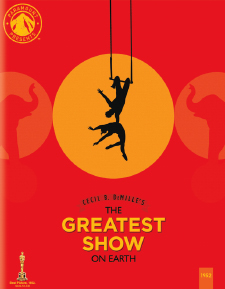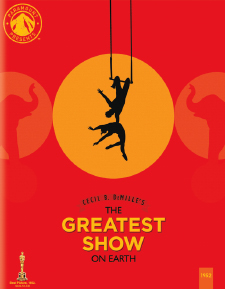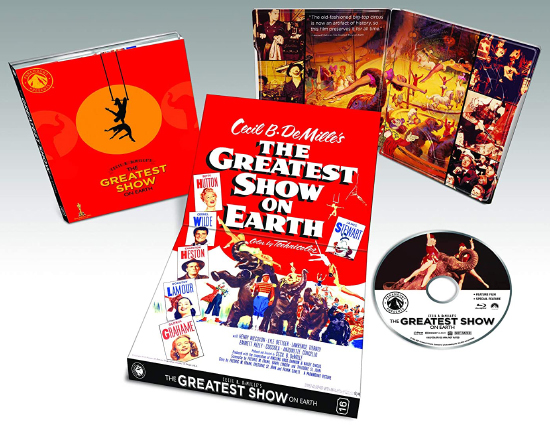Greatest Show on Earth, The: Paramount Presents (Blu-ray Review)

Director
Cecile B. DeMilleRelease Date(s)
1952 (March 30, 2021)Studio(s)
Paramount Pictures (Paramount Presents #16)- Film/Program Grade: C+
- Video Grade: A
- Audio Grade: B
- Extras Grade: C-
Review
The Greatest Show on Earth is a spectacle that combines the stories of various circus folks with the mechanics of moving the Ringling Bros, Barnum & Bailey circus from town to town while battling the elements, time, and the idiosyncrasies of the performers. Directed by Cecil B. DeMille, it uses a semi-documentary approach to trace the lives, aspirations, flaws, and nobility of those who have made the circus their life’s work.
Brad Braden (Charlton Heston) is a circus manager with “sawdust in his blood” whose job is to ensure that the enterprise keeps moving. He places the circus above all else, including personal relationships, which often makes him appear abrupt and uncaring. Holly (Betty Hutton), the star aerialist, has an eye for Brad, is miffed when she learns that he has hired trapeze superstar The Great Sebastian (Cornel Wilde) to take her place in the center ring. Angel (Gloria Grahame) is an elephant trainer’s assistant. Phyllis (Dorothy Lamour) poses on floats, works in the ensemble, and does a hula specialty. Buttons the Clown (James Stewart) hides a terrible secret beneath his make-up. The film flits back and forth among these characters as they display jealousy, insecurity, bravado, and sometimes less-than-noble motivations.
Interspersed with these scenes are elaborate sequences of genuine Ringling Bros acts under the Big Top, introduced by the ringmaster (Robert Carson) in stentorian tones. They include Circus Serenade, a series of “albums” based on Disney characters, the Gay Nineties, Stephen Foster tunes, nursery rhymes, South American splendor, a Bouquet of American Beauty, and Christmas; parades of elephants; clown antics; and even an appearance by Hopalong Cassidy (William Boyd). These scenes are interesting up to a point but wear thin pretty quickly. DeMille often cuts away to audience members watching and reacting to the acts, with specific bits of “business” given to many. Keep an eye peeled for a couple of star cameos among the spectators.
Holly’s resentment of Sebastian leads her to try to top him during their acts. Whatever he does, she goes him one better. Their rivalry leads to tragedy when a fall nearly kills Sebastian. A couple of shady guys plot to rob the train that carries the circus’ gate receipts. This leads to the most spectacular scene in the film, a devastating train crash that threatens the very future of the traveling circus.
Hutton is a performer who always looks as if she’s on a caffeine high. Her playbook contains not a hint of subtlety and her brash personality is a good fit for the egocentric character of Holly. She has worked hard to win the center ring and is determined to defend it. Heston’s Brad is suitably hard-nosed about the logistics and economics of the enterprise. Under pressure to make the season profitable, he knows that Sebastian will draw bigger crowds and sets Holly’s feelings aside to hire him. He negotiates with John Ringling North (as himself) and is respected for his efficiency. Wilde plays Sebastian as a charmer who attempts to fit in with his fellow performers. He’s liked by everyone, but Holly is his biggest challenge. Lamour gets to do a specialty number, Lovely Luawanna Lady, and Grahame looks surprisingly comfortable in the jaws of or atop an elephant.
DeMille is both director and showman with The Greatest Show on Earth, taking the viewer behind the scenes of the country’s biggest circus. Scenes of the roustabouts putting up and tearing down the Big Top reveal the enormous amount of equipment, muscle, time, and coordination required. This process is repeated in town after town and it has to work like clockwork. The circus train carries its own tractors and heavy equipment in addition to the performers and animals. DeMille narrates these scenes, noting that the circus starting up after its winter recess in Florida is a “restless giant limbering its muscles.”
The new Blu-ray of Paramount Presents’ 4K restoration from the film’s original camera negative features 1080p resolution and is presented in the aspect ratio of 1.37:1. The picture is sharp with excellent contrast and the colors are vibrant. Technicolor is ideal for the film’s range of bright hues, especially in the floats and assorted “album” presentations in the Circus Serenade sequence. Holly wears sequined costumes with purple ostrich feathers and bright pink ruffles. Phyllis sits atop a float surrounded by multi-colored balloons, Sebastian wears emerald green tights and cape, Stewart wears chalk white face paint and a red rubber nose, and the wagons are bright red. Complexions are reproduced with pleasant creamy tones. Though the film was shot just before widescreen was introduced, the “big” moments, such as the aerial acts, the roustabouts putting up the tent, and the train wreck, look great.
The soundtracks are offered in 2.0 DTS-High Definition Master Audio in English, German, or French. Optional subtitles include English, English SDH, German, and French. The dialogue is clear and distinct throughout. Victor Young’s score conveys the excitement of the circus and features heavy brass and percussion. Ambient sound is balanced with dialogue in outdoor and more intimate scenes. There is always a sense of movement to emphasize that the circus never stands still. Hutton’s voice is breathy and energetic, while Heston and Wilde are more natural in their delivery. Grahame and Lamour speak like veterans of show biz, with an “I’ve seen it all” tone. Hutton and Lamour have solo numbers. The train wreck’s excitement is enhanced by terrific sound effects that make miniatures seem like the real thing as one train crashes into another, derailing and twisting the screeching cars and smashing them into dirt hills.
Bonus materials on the Region Free Blu-ray release, the 16th in the Paramount Presents series, include only one disc-based extra: Filmmaker Focus: Leonard Maltin on The Greatest Show on Earth. The disc contains 23 chapters for easy access, and the slipcase housing opens up to reveal a color reprint of the original poster. Inside is a clear amaray case containing photos from the film and a quote from Leonard Maltin. A digital code is also included on a paper insert.
Filmmaker Focus: Leonard Maltin on The Greatest Show on Earth – Maltin notes that Cecil B. DeMille was one of the most famous directors of his era, which spanned the teens through the 1950s. He was a great self-promoter and many of his films, though corny, were always entertaining. After World War II, Hollywood had become fascinated with the documentary style of filmmaking. Though it was rare for DeMille to adopt this style, he went on the road with the circus for several months and was taken with what he saw. He asked a sketch artist who accompanied him to make a drawing of whatever he found interesting so the moments could be recreated on film. Paramount paid Ringling Bros “a small fortune” for unlimited access to everything including their performers. DeMille creates momentum right from the start in documentary-like scenes of the circus mobilizing to go on the road and set up the Big Top in towns across America. The film is “a snapshot of what circus life was like at a moment in time.” Charlton Heston had made only one film before, Dark City. Betty Hutton was a popular, “bombastic” Paramount musical performer. She and Cornel Wilde did their own aerial stunts. Gloria Grahame, too, did her own stunts with elephants. James Stewart, learning that DeMille would be making a circus picture, called him and asked if he could play a clown. The train wreck sequence was accomplished by miniatures combined with live action. The Greatest Show on Earth is testament to DeMille not only as a great storyteller, but as a great showman.
The Greatest Show on Earth won the Best Picture Oscar in 1953, beating High Noon and The Quiet Man. Over the years, this award has been controversial. Seen today, its flaws are obvious—a script of little substance, excessive circus splash, uninspired performances, an overlong running time, general corniness, and a focus on spectacle over story. Ringling Bros closed down permanently in 2017 and the film hasn’t aged well, but it still has value as a time capsule of what the circus once was. DeMille would make only one more film—a Technicolor remake The Ten Commandments—returning to big storytelling. His glimpses of real circus life still inspire admiration for an enterprise that once regularly thrilled children and adults alike.
- Dennis Seuling


